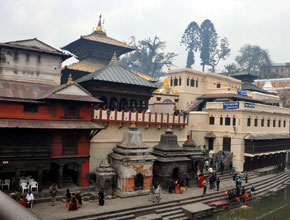

UNESCO again warns of delisting Pashupati from World Heritage Site

For the third time in the past three years, the United Nations Educational Scientific and Cultural Organization (UNESCO) has warned of removing the Pashupatinath Temple from its list of World Heritage Sites if the government fails to block a road track that passes through the Shleshmantak forest.
In a letter recently sent to the Department of Archeology (DoA), the UNESCO has asked that the government to completely block the 400 meters-track, which it says stops the Pashupatinath temple from meeting standards to qualify as a World Heritage Site. The UNESCO has categorically asked the government to block the road track completely by June, 2014.
According to the UNESCO standards, the construction of roads and buildings and entry of vehicles is strictly prohibited in any World Heritage Site.
But, the government did not meet the UNESCO standards by failing to preserve the Pashupatinath Temple without distorting its original structure. As a result, the UNESCO had to issue yet another warning in just three years´ time.
In its warning letter, the UNESCO has also asked that the government to build the compound wall around the temple complex and initiate efforts to renovate the old structures at the earliest.
"We tried a lot to stop the construction of the road track in Sheleshmantak forest but the local people stood against us," says Keshav Sthapit, Chief of the Kathmandu Valley Town Development Authority (KVTDA). "This road is not necessary as there are many other routes that the local people can use."
According to Bhesh Narayan Dahal, the DoA Director General, the UNESCO is sending its representatives to Nepal in three months to see if the government has really initiated works such as planting trees on the unwarranted road track and renovating old structures of the temple.
"While opening the road track, many trees were cut down and the original structure of the area was distorted," says Sushil Nahata, former member secretary of the Pashupati Area Development Trust (PADT). "After the repeated warnings from the UNESCO, the DoA had asked the Department of Roads (DoR) to stop the construction of the road completely."
As per its previous plan, the DoR wanted to build a blacktopped road through the Shleshmantak forest. Following the UNESCO´s objection, the DoR shunned its plan and did not blacktop the track. Now, the UNESCO wants the government to restore the track to its natural state.
Even though the DoR did not blacktop the road, people and vehicles still use this track, which passes through the Shleshmantak forest. They find it as one of the shortest routes to reach Mulpani and Gothatar from Tilganga area.
The government had decided to open the Tilganga-Guheshwori road track when the UCPN (Maoist) leader Hisila Yami was the Minister for Physical Infrastructure and Transport in 2007. With the support of the local people, the DoR successfully opened the track. But, when the UNESCO issued the second warning letter, the government stopped the construction work a year ago.
"We immediately stopped the construction work after we got order from the government," says Gopal Khadka, Chief of the Kathmandu Road Division at the DoR. "But the local people are not happy with our decision and want us to blacktop the road."
Pashupatinath was listed in the UNESCO´s World Heritage Site in October, 1979. Along with Pashupatinath, six other sites of Kathmandu, including Hanuman Dhoka durbar square, Patan durbar square, Bhaktapur durbar square, Swayambhu, Bouddhanath and Changu Narayan were were also put on the coveted list.
source: republica,9 July 2013








